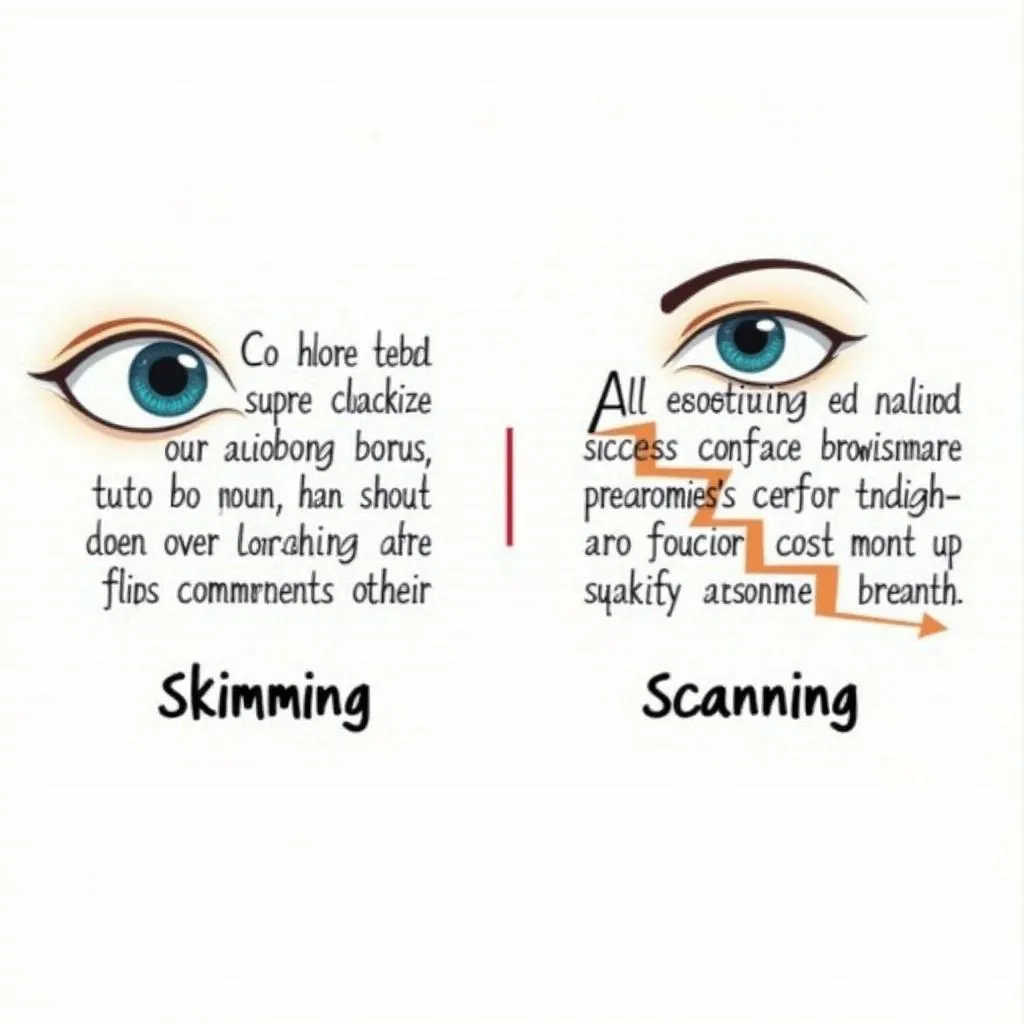Understanding Skimming and Scanning in IELTS Reading
Skimming and scanning are two essential techniques that can significantly improve your performance in the IELTS Reading test. These strategies allow you to quickly locate specific information and grasp the main ideas of a text, which is crucial given the time constraints of the exam.
Nội dung bài viết
- Understanding Skimming and Scanning in IELTS Reading
- What is Skimming?
- What is Scanning?
- Implementing Skimming and Scanning in IELTS Reading
- Step-by-Step Guide to Skimming
- Effective Scanning Techniques
- Practice Exercises for Skimming and Scanning
- Skimming Practice
- Scanning Practice
- Common Mistakes to Avoid
- Advanced Tips for IELTS Reading Success
- Next Steps in Your IELTS Preparation
What is Skimming?
Skimming involves quickly running your eyes over a text to get a general idea of what it’s about. It’s like taking a bird’s eye view of the passage without reading every word. When skimming, you focus on:
- Headings and subheadings
- The first and last sentences of paragraphs
- Any bold or italicized text
- Visual information like charts or graphs
Skimming helps you understand the overall structure and main points of the text, which is particularly useful for answering questions about the general idea or purpose of the passage.
What is Scanning?
Scanning is the technique of searching for specific information within a text. It involves moving your eyes quickly down the page seeking particular words or phrases. When scanning, you:
- Look for keywords related to the information you need
- Use headings and subheadings as guides
- Pay attention to names, dates, and numbers
Scanning is especially helpful when you need to find answers to specific questions or locate particular details within the passage.

Implementing Skimming and Scanning in IELTS Reading
Step-by-Step Guide to Skimming
- Read the title and any subtitles to get an initial idea of the topic.
- Look at any images, charts, or graphs and their captions.
- Read the first and last paragraphs, as they often contain key information.
- Read the first and last sentences of each paragraph.
- Note any words in bold, italics, or different font sizes.
This process should take no more than 2-3 minutes for a typical IELTS Reading passage.
Effective Scanning Techniques
- Identify the key information you’re looking for (e.g., a date, name, or specific term).
- Predict where in the text this information might be located.
- Move your eyes quickly down the page, looking for your target words or phrases.
- When you find a potential answer, read the surrounding text carefully to confirm.
Scanning should be even quicker than skimming, often taking less than a minute per question.
Practice Exercises for Skimming and Scanning
To improve your skimming and scanning skills, try these exercises:
Skimming Practice
- Set a timer for 2 minutes.
- Skim an IELTS-style passage.
- Without looking back at the text, write down the main topic and 3-4 key points.
- Check your answers against the passage.
Scanning Practice
- Choose an IELTS Reading passage.
- Create 5-10 questions that require specific information (dates, names, numbers).
- Set a timer for 3 minutes.
- Scan the text to find answers to your questions.
- Check your accuracy and speed.
Common Mistakes to Avoid
- Reading every word: This wastes precious time. Trust your skimming and scanning skills.
- Ignoring text features: Headings, bold text, and italics are there to guide you.
- Getting distracted by unfamiliar words: Focus on understanding the overall meaning.
- Not practicing enough: These skills improve with regular practice.
- Panicking under time pressure: Stay calm and trust your techniques.
Advanced Tips for IELTS Reading Success
- Develop your vocabulary: A broader vocabulary makes skimming and scanning more effective.
- Practice with various text types: IELTS uses academic, general, and technical texts.
- Time yourself regularly: Gradually decrease your time limits to improve speed.
- Use context clues: When scanning, the surrounding text can help confirm if you’ve found the correct information.
- Combine techniques: Use skimming to understand the passage structure, then scan for specific details.
Next Steps in Your IELTS Preparation
Now that you understand the importance of skimming and scanning, incorporate these techniques into your daily reading practice:
- Set aside 15-20 minutes each day for focused skimming and scanning exercises.
- Use a variety of texts, including news articles, academic papers, and IELTS practice materials.
- Gradually increase the difficulty and length of the passages you practice with.
- Take full-length IELTS Reading practice tests to apply these skills under exam conditions.
- Reflect on your performance and identify areas for improvement.
Remember, mastering skimming and scanning is just one aspect of IELTS Reading preparation. Continue to work on your overall reading comprehension, vocabulary, and time management skills for comprehensive improvement.
By consistently applying these techniques and following the advice provided, you’ll be well on your way to achieving your target score in the IELTS Reading test. Keep practicing, stay focused, and approach your preparation with confidence!